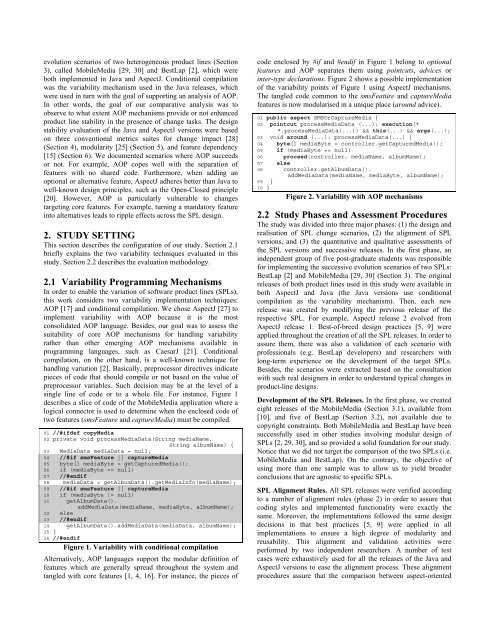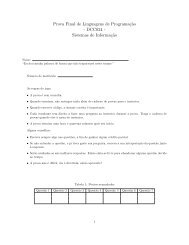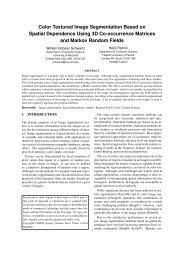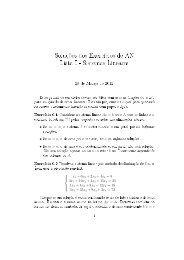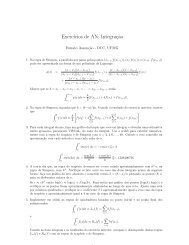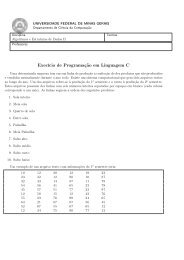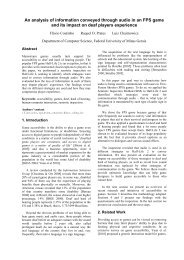Evolving Software Product Lines with Aspects: An Empirical ... - UFMG
Evolving Software Product Lines with Aspects: An Empirical ... - UFMG
Evolving Software Product Lines with Aspects: An Empirical ... - UFMG
Create successful ePaper yourself
Turn your PDF publications into a flip-book with our unique Google optimized e-Paper software.
evolution scenarios of two heterogeneous product lines (Section<br />
3), called MobileMedia [29, 30] and BestLap [2], which were<br />
both implemented in Java and AspectJ. Conditional compilation<br />
was the variability mechanism used in the Java releases, which<br />
were used in turn <strong>with</strong> the goal of supporting an analysis of AOP.<br />
In other words, the goal of our comparative analysis was to<br />
observe to what extent AOP mechanisms provide or not enhanced<br />
product line stability in the presence of change tasks. The design<br />
stability evaluation of the Java and AspectJ versions were based<br />
on three conventional metrics suites for change impact [28]<br />
(Section 4), modularity [25] (Section 5), and feature dependency<br />
[15] (Section 6). We documented scenarios where AOP succeeds<br />
or not. For example, AOP copes well <strong>with</strong> the separation of<br />
features <strong>with</strong> no shared code. Furthermore, when adding an<br />
optional or alternative feature, AspectJ adheres better than Java to<br />
well-known design principles, such as the Open-Closed principle<br />
[20]. However, AOP is particularly vulnerable to changes<br />
targeting core features. For example, turning a mandatory feature<br />
into alternatives leads to ripple effects across the SPL design.<br />
2. STUDY SETTING<br />
This section describes the configuration of our study. Section 2.1<br />
briefly explains the two variability techniques evaluated in this<br />
study. Section 2.2 describes the evaluation methodology.<br />
2.1 Variability Programming Mechanisms<br />
In order to enable the variation of software product lines (SPLs),<br />
this work considers two variability implementation techniques:<br />
AOP [17] and conditional compilation. We chose AspectJ [27] to<br />
implement variability <strong>with</strong> AOP because it is the most<br />
consolidated AOP language. Besides, our goal was to assess the<br />
suitability of core AOP mechanisms for handling variability<br />
rather than other emerging AOP mechanisms available in<br />
programming languages, such as CaesarJ [21]. Conditional<br />
compilation, on the other hand, is a well-known technique for<br />
handling variation [2]. Basically, preprocessor directives indicate<br />
pieces of code that should compile or not based on the value of<br />
preprocessor variables. Such decision may be at the level of a<br />
single line of code or to a whole file. For instance, Figure 1<br />
describes a slice of code of the MobileMedia application where a<br />
logical connector is used to determine when the enclosed code of<br />
two features (smsFeature and captureMedia) must be compiled.<br />
01 //#ifdef copyMedia<br />
02 private void processMediaData(String mediaName,<br />
String albumName) {<br />
03 MediaData mediaData = null;<br />
04 //#if smsFeature || captureMedia<br />
05 byte[] mediaByte = getCapturedMedia();<br />
06 if (mediaByte == null)<br />
07 //#endif<br />
08 mediaData = getAlbumData().getMediaInfo(mediaName);<br />
09 //#if smsFeature || captureMedia<br />
10 if (mediaByte != null)<br />
11 getAlbumData().<br />
addMediaData(mediaName, mediaByte, albumName);<br />
12 else<br />
13 //#endif<br />
14 getAlbumData().addMediaData(mediaData, albumName);<br />
15 }<br />
16 //#endif<br />
Figure 1. Variability <strong>with</strong> conditional compilation<br />
Alternatively, AOP languages support the modular definition of<br />
features which are generally spread throughout the system and<br />
tangled <strong>with</strong> core features [1, 4, 16]. For instance, the pieces of<br />
code enclosed by #if and #endif in Figure 1 belong to optional<br />
features and AOP separates them using pointcuts, advices or<br />
inter-type declarations. Figure 2 shows a possible implementation<br />
of the variability points of Figure 1 using AspectJ mechanisms.<br />
The tangled code common to the smsFeature and captureMedia<br />
features is now modularised in a unique place (around advice).<br />
01 public aspect SMSOrCaptureMedia {<br />
02 pointcut processMediaData (...): execution(*<br />
*.processMediaData(...)) && this(...) && args(...);<br />
03 void around (...): processMediaData(...) {<br />
04 byte[] mediaByte = controller.getCapturedMedia();<br />
05 if (mediaByte == null)<br />
06 proceed(controller, mediaName, albumName);<br />
07 else<br />
08 controller.getAlbumData().<br />
addMediaData(mediaName, mediaByte, albumName);<br />
09 }<br />
10 }<br />
Figure 2. Variability <strong>with</strong> AOP mechanisms<br />
2.2 Study Phases and Assessment Procedures<br />
The study was divided into three major phases: (1) the design and<br />
realisation of SPL change scenarios, (2) the alignment of SPL<br />
versions, and (3) the quantitative and qualitative assessments of<br />
the SPL versions and successive releases. In the first phase, an<br />
independent group of five post-graduate students was responsible<br />
for implementing the successive evolution scenarios of two SPLs:<br />
BestLap [2] and MobileMedia [29, 30] (Section 3). The original<br />
releases of both product lines used in this study were available in<br />
both AspectJ and Java (the Java versions use conditional<br />
compilation as the variability mechanism). Then, each new<br />
release was created by modifying the previous release of the<br />
respective SPL. For example, AspectJ release 2 evolved from<br />
AspectJ release 1. Best-of-breed design practices [5, 9] were<br />
applied throughout the creation of all the SPL releases. In order to<br />
assure them, there was also a validation of each scenario <strong>with</strong><br />
professionals (e.g. BestLap developers) and researchers <strong>with</strong><br />
long-term experience on the development of the target SPLs.<br />
Besides, the scenarios were extracted based on the consultation<br />
<strong>with</strong> such real designers in order to understand typical changes in<br />
product-line designs.<br />
Development of the SPL Releases. In the first phase, we created<br />
eight releases of the MobileMedia (Section 3.1), available from<br />
[10], and five of BestLap (Section 3.2), not available due to<br />
copyright constraints. Both MobileMedia and BestLap have been<br />
successfully used in other studies involving modular design of<br />
SPLs [2, 29, 30], and so provided a solid foundation for our study.<br />
Notice that we did not target the comparison of the two SPLs (i.e.<br />
MobileMedia and BestLap). On the contrary, the objective of<br />
using more than one sample was to allow us to yield broader<br />
conclusions that are agnostic to specific SPLs.<br />
SPL Alignment Rules. All SPL releases were verified according<br />
to a number of alignment rules (phase 2) in order to assure that<br />
coding styles and implemented functionality were exactly the<br />
same. Moreover, the implementations followed the same design<br />
decisions in that best practices [5, 9] were applied in all<br />
implementations to ensure a high degree of modularity and<br />
reusability. This alignment and validation activities were<br />
performed by two independent researchers. A number of test<br />
cases were exhaustively used for all the releases of the Java and<br />
AspectJ versions to ease the alignment process. These alignment<br />
procedures assure that the comparison between aspect-oriented


